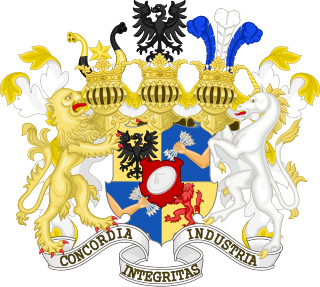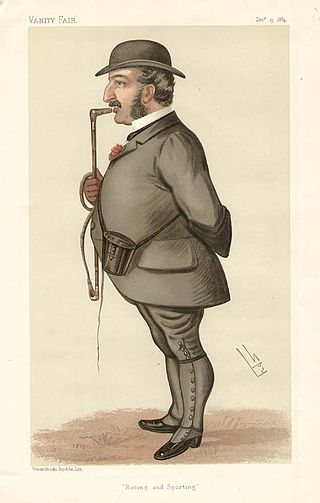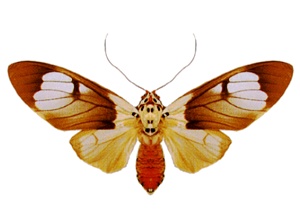
The Rothschild family is a wealthy Ashkenazi Jewish noble banking family originally from Frankfurt that rose to prominence with Mayer Amschel Rothschild (1744–1812), a court factor to the German Landgraves of Hesse-Kassel in the Free City of Frankfurt, Holy Roman Empire, who established his banking business in the 1760s. Unlike most previous court factors, Rothschild managed to bequeath his wealth and established an international banking family through his five sons, who established businesses in London, Paris, Frankfurt, Vienna, and Naples. The family was elevated to noble rank in the Holy Roman Empire and the United Kingdom. The family's documented history starts in 16th century Frankfurt; its name is derived from the family house, Rothschild, built by Isaak Elchanan Bacharach in Frankfurt in 1567.

Lionel Walter Rothschild, 2nd Baron Rothschild, Baron de Rothschild, was a British banker, politician, zoologist and soldier, who was a member of the Rothschild family. As a Zionist leader, he was presented with the Balfour Declaration, which pledged British support for a Jewish national home in Palestine. Rothschild was the president of the Board of Deputies of British Jews from 1925 to 1926.

Baron Rothschild, of Tring in the County of Hertfordshire, is a title in the Peerage of the United Kingdom. It was created in 1885 for Sir Nathan Rothschild, 2nd Baronet, a member of the Rothschild banking family. He was the first Jewish member of the House of Lords not to have previously converted to Christianity. The current holder of the title is Nathaniel Rothschild, 5th Baron Rothschild, who inherited the barony in February 2024.

Leopold de Rothschild was a British banker, thoroughbred race horse breeder, and a member of the prominent Rothschild family.

Major Lionel Nathan de Rothschild, OBE was a British banker and Conservative politician best remembered as the creator of Exbury Gardens by the New Forest in Hampshire. He was the eldest son of Leopold de Rothschild (1845–1917) and a part of the prominent Rothschild banking family of England. In 1910, he was elected to the House of Commons. In 1917, he co-founded the anti-Zionist League of British Jews.

The Rothschild banking family of England is the English branch of the Rothschild family. It was founded in 1798 by Nathan Mayer Rothschild (1777–1836), who first settled in Manchester before moving to London, England, which was then part of the Kingdom of Great Britain. He was sent there from his home in Frankfurt by his father, Mayer Amschel Rothschild (1744–1812). Wanting his sons to succeed on their own and to expand the family business across Europe, Mayer Amschel Rothschild had his eldest son remain in Frankfurt, while his four other sons were sent to different European cities to establish a financial institution to invest in business and provide banking services. Nathan Mayer Rothschild, the third son, first established a textile jobbing business in Manchester and from there went on to establish N M Rothschild & Sons bank in London.
Anthony Gustav de Rothschild was a British banker and member of the Rothschild family.

Amerila is a genus of moths in the subfamily Arctiinae.

Idalus is a genus of moths in the family Erebidae. The genus was erected by Francis Walker in 1855.

Bradina is a genus of moths of the family Crambidae.

Xylophanes is a genus of moths in the family Sphingidae erected by Jacob Hübner in 1819. As of 2000, there are about 96 species and subspecies included in the genus.

Stenoglene is a genus of moths in the family Eupterotidae from Africa. The genus was described by Felder in 1874.
Elysius meridionalis is a moth of the family Erebidae. It was described by Walter Rothschild in 1917. It is found in Brazil.
Hoplojana is a genus of moths in the family Eupterotidae.
Acrojana is a genus of moths in the family Eupterotidae.

Cotana is a genus of moths in the family Eupterotidae.

Melanothrix is a genus of moths in the family Eupterotidae.
Hemijana subrosea is a moth in the family Eupterotidae. It was described by Per Olof Christopher Aurivillius in 1893. It is found in Angola and South Africa.
Hemijana variegata is a moth in the family Eupterotidae. It was described by Rothschild in 1917. It is found in Mozambique.

Various cultures throughout Africa utilize insects for many things and have developed unique interactions with insects: as food sources, for sale or trade in markets, or for use in traditional practices and rituals, as ethnomedicine or as part of their traditional ecological knowledge. As food, also known as entomophagy, a variety of insects are collected as part of a protein rich source of nutrition for marginal communities. Entomophagy had been part of traditional culture throughout Africa, though this activity has been diminishing gradually with the influx of Western culture and market economies. Often the collection of insects for food has been the activity of children, both male and female.













